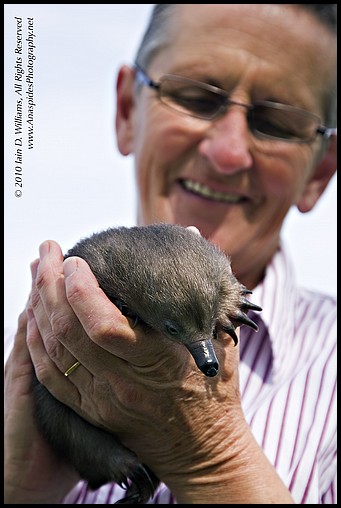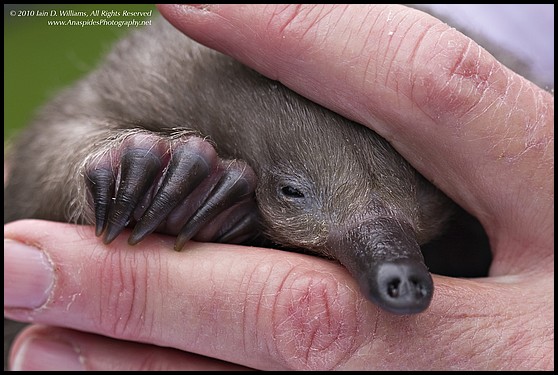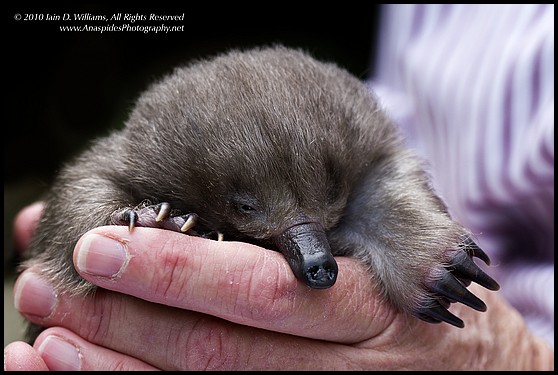Tasmanian Wildlife Carer Rehabilitates Australian Short-beaked Echidna
 Tuesday, April 20, 2010 at 2:00AM
Tuesday, April 20, 2010 at 2:00AM  Recently I was asked to photograph a small Australian Short-beaked echidna (Tachyglossus aculeatus) that been found alongside a walkway in southern Tasmania. The young orphan had been discarded by its mother for some reason and a “good samaritan” had found the nymph and passed it along to “wildlife carers” to nurture and hopefully rehabilitate to the wild.
Recently I was asked to photograph a small Australian Short-beaked echidna (Tachyglossus aculeatus) that been found alongside a walkway in southern Tasmania. The young orphan had been discarded by its mother for some reason and a “good samaritan” had found the nymph and passed it along to “wildlife carers” to nurture and hopefully rehabilitate to the wild.
Observing let along photographing an echidna this young is uncommon; usually they are still in the mother’s pouch (actually a fold of skin) or are left in the burrow whilst mother is out and about searching for food. To see a very young echidna usually means that the mother has been killed or has “dumped” the baby for some reason. Echidnas frequently are killed by vehicles along roads and by farming practices (farming ploughs often dig up mother echidnas and their young), but in this case the mother was nowhere to be found. Why the youngster was ousted from the pouch so early and what happened to the mother are questions that were to remain unanswered.
LEFT: Australian Short-beaked Echidna & wildlife carer pose for the camera - meet "Young Quills"
The wildlife carer cared for the baby echidna for several weeks feeding the young urchin every 2-3 days with a specially brewed high protein, high fat milk which replicated, as much as possible, the milk that would have been supplied by the mother. The milk is administered to the infant by a micro pipet usually used in chemistry classes to deliver defined and accurate volumes of whatever to a test tube. The echidna, nicknamed “young quills” lapped up the rich liquid with his exceptionally long and sticky tongue; only becoming less active when his full was taken. After the 10-15 feeding it was time to return to a long sleep to digest the liquid meal.
To house the echidna, a special basket was used that was lined with soft loose material. The basket was kept in a specially heated room in an attempt to replicate the warmth of the mother’s pouch or burrow, and had a lid to ensure the inside was in more or less perpetual darkness. The only time Quills was allowed to exit the pseudo pouch was for feeding. Young Quills grew quickly and put on substantial weight and his fluffy fur was soon to be replaced with more defined fur along with the beginnings of the many spines that this critter is known for.
 All seemed well for Quills and the next stage of the rehabilitation was being put in place. It was planned that after reaching a certain size, Quills would leave his initial wildlife carer to be relocated to another carer whose task was to teach the young Quills how to search for and eat ants; the favoured food of the echidna. Usually this would be done by the mother echidna (obviously), however, in this case a carer would have to act as a surrogate mother. After a month or so of teaching, Quills would have then been released into the wild to fend for himself.
All seemed well for Quills and the next stage of the rehabilitation was being put in place. It was planned that after reaching a certain size, Quills would leave his initial wildlife carer to be relocated to another carer whose task was to teach the young Quills how to search for and eat ants; the favoured food of the echidna. Usually this would be done by the mother echidna (obviously), however, in this case a carer would have to act as a surrogate mother. After a month or so of teaching, Quills would have then been released into the wild to fend for himself.
LEFT: The claws of Australian Short-beaked Echidnas are exceptionally sharp and strong. Echidnas have the ability to burrow quickly beaneth the ground.
However, this was not to be! Quills died in the early morning. The reason behind his death was unknown; the carer had done everything in her power to look after Quills. As baby echidnas are uncommon, the reasons for Quill’s death were important so that carers could learn from the event. An autopsy was performed by a Government Veterinarian in an attempt to determine the reason for Quills’ untimely departure from the natural world. Although nothing definite could be established, adhesions around the heart were found. Whether this may have been a cause for the animal to be discarded from the mother is unknown.
 Wildlife Carers are located in all Australian states and donate their time to care for native animals in distress; often when food and medical supplies are low they dig deep into their own pockets to purchase essential items.
Wildlife Carers are located in all Australian states and donate their time to care for native animals in distress; often when food and medical supplies are low they dig deep into their own pockets to purchase essential items.
LEFT: Juvinile Australian Short-beaked Echidnas lack the basic survival skills until taught my the mother.
If you discover a lost or injured native animal, don’t ignore it. Carefully remove the animal from danger (road, etc) and place it in either a darkened sack or a box with a lid. It’s important to ensure the animal is kept warm, quiet and in darkness, as this will lessen the stress for the animal.
To contact a wildlife carer in Tasmania (Australia), call the Injured and Orphaned Wildlife Programme on (03) 6233 6556. Feel free to make comments on this post in the comments section below.


